Latest News
Kitchen Chat and more…
Kitchen Chat and more…

Loch Lomond (Source)
Loch Lomond is the largest Scottish loch. It is a beautiful place with many exciting tourist attractions along the way. One could stop by the Loch to try and spot Nessie, followed by a lunch picnic if one is so inclined.
The team at WhiskyGeeks, however, was after the treasure to be found at Loch Lomond. The whiskies at Loch Lomond Distillery are not just one or two styles like many other distilleries. We attended an online tasting with the Master Distiller of Loch Lomond Group, Bill White and Whisky Blender, Ashley Smith to learn more.
Before we dive into the whisky part, let us take a walk down memory lane to see how Loch Lomond and its distillery started.
If you are wondering why our title talks about the sun shining on Loch Lomond, it is a line from a traditional Scottish song “The Bonnie Banks o’ Loch Lomond”. Published in 1841 in Vocal Melodies of Scotland, the song referred to the Battle of Culloden Moor where the Scottish soldiers, led by Bonnie Prince Charlie, was unsuccessful in their attempt to overthrow the King of England, George II.
The song tells the story of two soldiers who were imprisoned at Carlisle Castle. One of them would die while the other would go free. According to Celtic legend, if a Celt dies in a foreign land, his spirit would travel back home via “the low road”, which is the road for the soul. In the song, the soldier to be executed sang, “O ye’ll tak’ the high road, and I’ll tak’ the low road”. The story is bittersweet, and you can learn more about the song from here.
Loch Lomond distillery has its history seeped in the six Celtic clans that surround the loch. These clans include the Colquhoun, McFarlane, Galbraith, Macaulay, MacGregor, Menzies and Buchanan. The above map taken from the Loch Lomond distillery website showed how the clans surrounded the loch. We are not sure why or how Stewart and Cunningham come into the picture, though.
If you looked at the map, you would see on the top, a mark named “Original Distillery”. This is the site where the first Loch Lomond distillery was built. The former Loch Lomond dated back to 1814, at the northern part of Loch Lomond near Tarbat. It is no longer there today, and nobody knew what happened or when it closed. Wikipedia said that it closed in 1817, but it is still unverified today.
The current Loch Lomond distillery opened in 1964. Built by the owners of the now-defunct Littlemill Distillery (the irony!), the distillery is now down south of Loch Lomond, in the village of Bowling. Malt production started in 1965 and continued to 1984 before the distillery was mothballed for three years. It restarted production after Glen Catrine Bonded Warehouse bought the business in 1987. The owners then began grain distillation in 1993 and added two new malt stills in 1999. In 2014, the private equity group Exponent bought the distillery. After five years, Chinese Hillhouse Capital bought over the Loch Lomond Group in June 2019.
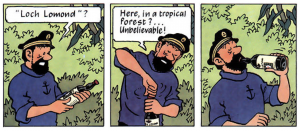
Source: Tintin Comics: Tintin and the Picaros.
Loch Lomond is a whisky for the everyday drinker and the geeks! No wonder Captain Haddock from the TinTin series loved it! With eight styles of single malt distillation, single grain and various kinds of yeast used, this sounds like a Japanese whisky distillery in the heart of Scotland. With so many variables, let’s shed some light to get our heads around Loch Lomond whisky
Many Japanese whisky distilleries play around with various yeast types and distillation styles, like those from Mars or Suntory; and in that regard, Loch Lomond does something similar. Despite that, Loch Lomond only uses Scottish barley. Other than unpeated barley, the distillery takes in peated barley at 25ppm and 50ppm. The barley is peated by a maltster, but the peat used originates from Carnoustie.
Many other distilleries have fermentation times of 48-50 hours as that is enough to maximise alcohol yield, as seen in the graph below. However, Loch Lomond takes a whopping 92 hours for its fermentation! This longer fermentation encourages esterification and adds fruitier flavours.
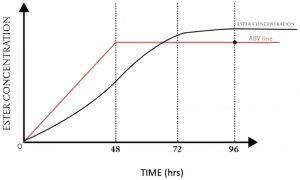
Graph of Ester Conc and abv over time. Source: Loch Lomond Slides
There are eight styles of single malt distillation and two styles of single grain. I know this is a lot to take in, but it is all summarised in the picture below from Loch Lomond’s twitter.
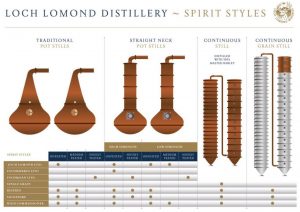
Loch Lomond Spirit Styles. Source: https://twitter.com/LochLomondMalts/status/1115922419271729152
The straight-neck stills are a bit confusing. The High Strength refers to the higher average strength of distillate due to the increased reflux from a cooling ring (see: partial condenser), and Low Strength refers to the lower average strength of distillate when the cooling ring is not used. With the added reflux for their High Strength distillation, the stillmen increases the heating of the straight neck pot still to keep the distillate flow rate, and hence the duration of distillation, constant.
Now let’s talk drams! 😀 (Note: I will be giving my commentary rather than just tasting notes)
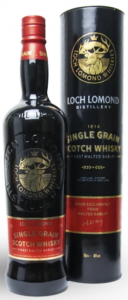
Single Grain. Photo Credits: whiskystore.com.sg
Unlike almost all other scotch single grains, the mash bill is comprised of 100% Malted Barley. The spirit runs off a continuous still at 85% rather than 94%, which means that more cogeners will be present in the spirit, giving more body and flavour than almost all other Scottish single grains.
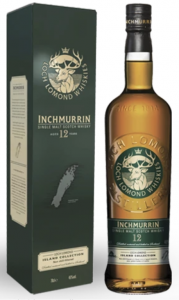
Inchmurrin 12yo. Photo Credits: whiskystore.com.sg
Entirely from Straight Neck Stills with reflux, this unpeated Whisky is very fruity. In my opinion, I found it to be especially orange-y. There will also be a Single Cask 10yo released exclusively for Whisky Journey 2020!
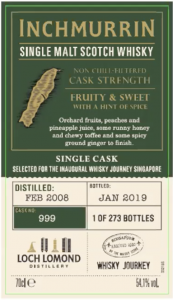
Sneak Peak of Inchmurrin Single Cask. Photo Credits: Loch Lomond and Whisky Journey
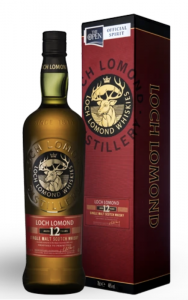
Loch Lomond 12yo. Photo Credits: whiskystore.com.sg
As seen in the helpful photo summary, Loch Lomond 12 Official Bottling is a blend of unpeated and medium peated Whisky. According to Ashley Smith, whisky blender at Loch Lomond, about 15% of this bottling is medium peated Whisky! This recipe gives this single malt a wonderfully complex blend of fruitiness and peat.
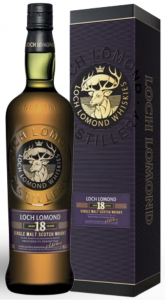
Loch Lomond 18yo. Photo Credits: whiskystore.com.sg
This OB is a rather dignified 18yo single malt! Although the fruitiness and peat were not as prominent as the 12yo, the musky and waxy notes take the lead. If you enjoy the waxy notes in Clynelish, you will enjoy this too!
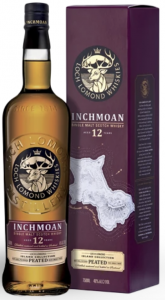
Inchmoan 12yo. Photo Credits: whiskystore.com.sg
As mentioned in the summarised table of spirit styles, Inchmoan is a blend of 50ppm distillates from both the swan-neck pot still and the straight-neck pot still. Despite that, the dram was a lot more balanced than expected, with fruity notes along with loud notes of minerality, earthiness and smoke!
Other than the names you would see in the core range, you may see other names pop up in old bottlings or independent bottlings like Glen Douglas, Old Rhosdhu, Craiglodge, Croftengea and Inchfad. The first two of those names being unpeated, and the last 3 being peated variants.
Inchfad and Croftengea are heavily peated (50ppm), while Craiglodge is lightly peated (25ppm). The ‘Old Rhosdhu’ name used to refer to a style of single malt distilled at Loch Lomond up to the year 2000. Today Rhosdhu is used internally to refer to the single grain distilled from 100% malted barley.

The WhiskyStore is the official distributor of the Loch Lomond whiskies. You can check out their online store to see the expression on sale!
If you are thinking of visiting once the pandemic tones down, do remember that the distillery does not accept visitors. You will have to try and contact them via email to check if you can visit. Otherwise, take a trip down to Loch Lomond and enjoy the beauty of the place.
We were excited to be part of the Glen Scotia Virtual Tasting hosted by The WhiskyStore. The distillery is part of the triplets in Campbeltown, but its smaller size often gets overshadowed by its neighbours. The team at WhiskyGeeks has been following Glen Scotia for some time now, as we find its liquids really palatable and beautifully matured.
It was, therefore, with great anticipation, when we joined the Zoom tasting on Tuesday, 14 July at 8 pm. Follow our journey as we partake in one of the greatest virtual geek fests with Glen Scotia!
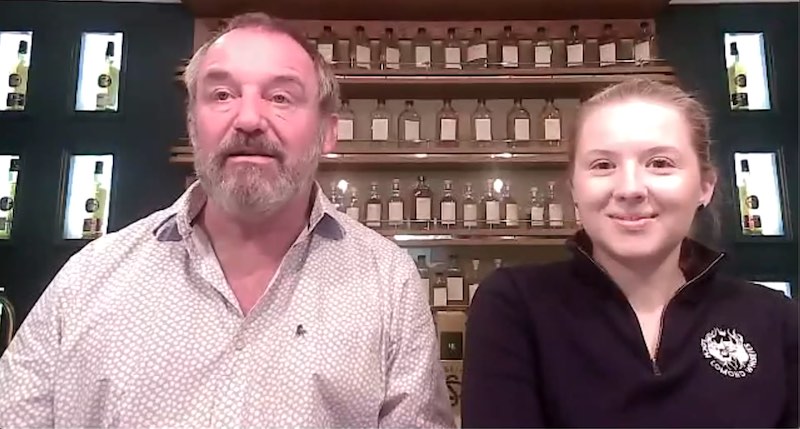
We had two speakers that evening. The first speaker was Mr Bill White, the master distiller for the Loch Lomond Group. Yes, Glen Scotia belongs to the Loch Lomond Group. Bill comes with years of experiences, with 22 years working in William Grant and Sons. He eventually became their Group Operations Director before he decided to join Loch Lomond Group as their master distiller around 2015.
The second speaker is Ms Ashley Smith, the master blender at Loch Lomond Group. Ashley has eight years old experience working in the whisky industry, but she has only joined the company for about ten months. Her work revolves around whisky blending (of course!) and she has her hands full with the single casks programme as well as ensuring that the core ranges from both Glen Scotia and Loch Lomond are consistent.
The year was 1597, and an act of Parliament established Lochhead. Settlers flocked to the sea-side town, and by 1607, various traders and settlers were setting up businesses in the town. The Kintyre peninsula (where Lochhead was) had plenty of local ingredients for distilling, and soon, industrious settlers built illicit stills to make whisky. It wasn’t until the mid-19 century that the town became Campbeltown, named after the local lairds, the Campbells!
Campbeltown quickly became the whisky capital, with 21 known illicit stills in the town and 10 in the surrounding countryside by 1795. There were probably more than 50 illegal distilleries in total by the 19 century. The Victorian Era was booming with economic activities, and there was a growing market for whisky both at home and in the USA. Cargo ships meant to carry whiskies to the USA would call at Glasgow and sail down the Clyde, called in at Campbeltown as their last port call before taking the journey to the USA. Therefore, the town proliferated to become the “whisky capital of the world”.
As the town prospered, the Dean of Guild James Stewart and Provost John Galbraith came together to build Scotia Distillery in 1832. In three short years, the distillery grew and thrived alongside the remaining 29 distilleries in Campbeltown. Disaster strike in 1923 when the Drumlemble Colliery closed, ending the era of cheap, local fuel in the town. Coupled with the Great Depression and the Prohibition in the USA, the distilleries in Campbeltown suffered tremendous losses. In a short nine years, only three distilleries remained in Campbeltown. Scotia was one of them.
The survival of Scotia distillery depended on its owners. James and John managed the distillery until 1895. It became one of the founding members of West Highland Malt Distilleries in 1919, with five other Campbeltown distilleries in an attempt to share costs and prevent closure. The project failed, and Scotia was left standing alone. In 1924, Duncan MacCallum purchased Scotia but closed to close in 1928. When he reopened the distillery in 1930, he met with an unfortunate scam in which he lost his savings and committed suicide. The Bloch Bros brought over Scotia and added the word “Glen” to its name. Glen Scotia was born.
The Bloch Bros saved Glen Scotia. They retained ownership of the distillery until 1954. That year, Canadian giant, Hiram Walker bought the distillery estate but quickly sold it to A.Gillies & Co – a blender in 12 months. The distillery changed hands again and became part of Amalgamated Distilled Products Ltd (ADP) which owned Barton Brands (including Loch Lomond). Glen Scotia started reconstruction works towards the end of the 1970s, but unfortunately, it closed between 1984 and 1989. During the closure, Gibson International bought over ADP’s distilling assets. Glen Scotia reopened in 1990 under new leadership. In 1994, Glen Catrine Bonded Warehouse Ltd bought over Glen Scotia and promptly mothballed in. It returned to full production only in 1999 under the Loch Lomond Distillers Group.
Glen Scotia produces both peated and unpeated whisky. The team dedicated six weeks per year to producing peated whisky. What I find interesting is that the distillery does two different styles of peated whisky. One is a mildly-peated whisky at 25ppm while the other is a heavily-peated whisky at 50ppm.
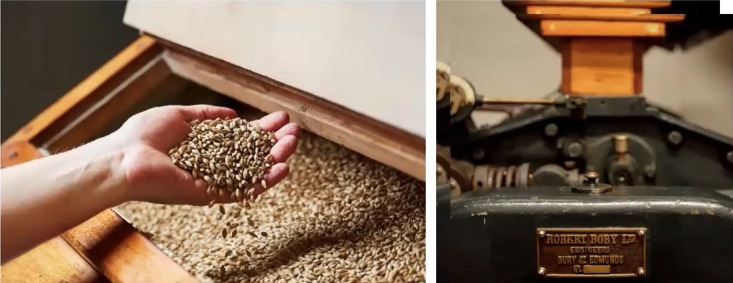
Source: Glen Scotia Presentation Slides
Glen Scotia sourced and used only Scottish malted barley from the east of Scotland. The grain undergoes milling in the Bobby Mill owned by Glen Scotia (See Ardbeg Distillery for more Bobby Mill description).

Source: Glen Scotia Presentation Slides
The mash tun is a relic at the distillery. Made of cast iron, it dated back to the Victorian era and held the history of the distillery within its pits. The mash tun uses a rack and pinion system (shown in the second picture above). The team uses four streams of water for wort extraction. The first two streams, with a temperature between 64 and 76 degrees Celsius, enable the collection of wort. The third and fourth streams, added at 85 degrees Celsius, allowing the collection of sparge. The process takes about eights hours to complete, and the distillery does ten mashes per week. The distillery’s water source is Crosshill Loch, providing them with fresh, clean, soft water.
The team cools the wort to around 17-18 degrees Celsius before pumping it into the washback for fermentation. The reason is to prevent the temperature from killing the active yeast.
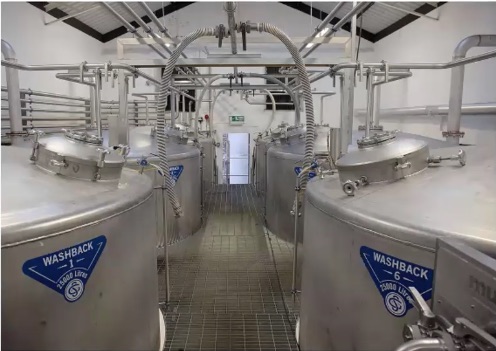
Source: Glen Scotia Presentation Slides
The fermentation at Glen Scotia is long, with each cycle lasting more 92 hours on average. The long hours creates what is known as a “second fermentation” where fruity esters are developed to give the wash a fruity flavour. The distillery uses commercial distiller yeast as it is best suited for them to create the fruity wash.
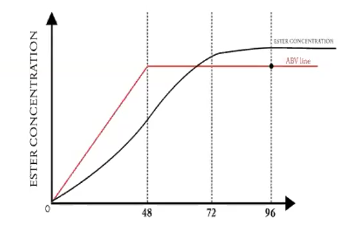
Source: Glen Scotia Presentation Slides
Look at the graph above. You will notice that after 48 hours, there is no longer alcohol production, but the ester concentration keeps going up. This is the reason why long fermentation produces fruity wash, which, in turn, will create a fruity spirit. The alcohol percentage of the wash is around 8-9% abv.
We understand that Glen Scotia has both internal and external washbacks. For the outer washbacks, they have cooling jackets on them to maintain the temperature at an ideal level.
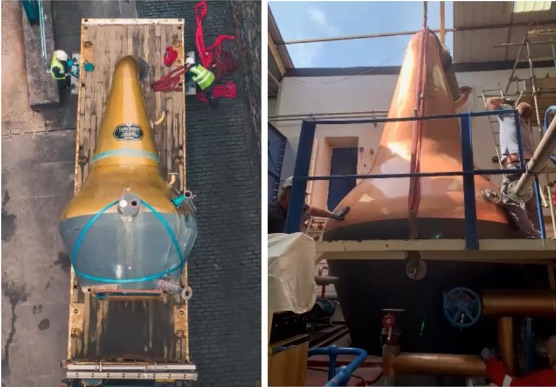
Source: Glen Scotia Presentation Slides
Glen Scotia owns a pair of stills and has a production capacity of 500,000 litres to 600,000 litres. They produced 535,000 litres of spirits in 2019. The distillery also installed a new spirit still in June 2020, making them look unique.
The wash still takes in the wash at 8-9% abv. After the first distillation, the low wines stands at around 25% abv. The spirit still then takes in the low wines and increase the alcohol percentage to about 74% abv. The foreshots or head is between 74% – 71% abv, while the heart runs from 71% to around 63% abv. The feints are below 63% abv.
The average alcohol percentage of the new spirit is 69% abv, and the distillation team will add water to lower the abv to 63.5% abv before transferring it to the casks for maturation.

Source: Glen Scotia Presentation Slides
Glen Scotia has three kinds of warehouses – dunnage at the Visitor Centre (around 150 casks), palletised and racked warehouses (for the rest of their casks). The different environment provided by the warehouse help Glen Scotia to achieve the differences in their whiskies, which work well for the brand. Currently, the distillery has about 12,000 casks onsite. Typically, the distillery fills 99.9% of their new spirits into first-fill ex-bourbon casks. We also understand from Bill that the oldest cask currently still maturing on site is over 45 years old! We were excited as Glen Scotia recently release a 45 years old bottling, which means there is a chance that they will release something older in future!
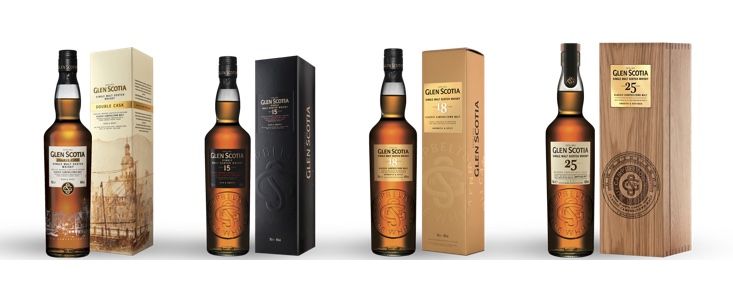
Source: The WhiskyStore
The WhiskyStore selected four whiskies for the session. My personal favourites are the 15 Years Old and the 25 Years Old, both of which showcased different styles. Every expression has its fans, but the 25 Years Old was the ultimate winner.
The Glen Scotia Double Cask is a non-age statement expression that is matured in ex-bourbon casks and finished 6 to 12 months in Pedro Ximenez casks. Bottled at 46% abv, it is gentle and easy to drink. The sweetness of the PX casks complements the bourbon maturation beautifully.
One of my personal favourites is the 15 years old expression. Matured fully in ex-bourbon American oak casks, the whisky is fruity with cedarwood and hints of pine trees. The sweet, fruity palate coupled with some dryness in the finish keeps me going for more.
The 18 years old expression is a favourite for many participants. Matured 17 years in refill ex-bourbon casks and finished one year in first-fill Oloroso sherry casks, the whisky is flavourful with a complexity of both bourbon and sherry influences.
Finally, the 25 years old expression is the crowd favourite! Matured fully in ex-bourbon American casks and then married in first-fill bourbon casks for the extra flavours, the 25 years old Glen Scotia is full-on fruity with tropical fruits such as pineapples, guava and hints of mangoes. It also developed vanilla, coconut and pine wood. The finish is not as dry as the 15 Years Old expression, but it continues to beckon me with its long finish.
The WhiskyStore is the official distributor of Glen Scotia in Singapore, and you can easily find all the above expression at their online store. If you are not ready to commit a bottle, you can still try the tasting sets available.
The Loch Lomond Powerhouse – Bill and Ashley – will be back next week with a Loch Lomond presentation! They promised that it would be another geekfest, one that is better than we had with Glen Scotia. If you enjoyed our post, don’t forget to head over to the Whisky Store to purchase your Loch Lomond Tasting Set and join us next week!
A seasoned drinker who loves his or her cask strength whiskies would have heard of Cadenhead whiskies. As Scotland’s oldest Independent Bottler, Cadenhead is the master when it comes to bottling spirits young and old. WhiskyGeeks is grateful to Sarah Thallon, the whisky guru at The WhiskyStore for inviting us to a Highland tasting of four Cadenhead whiskies recently.
William Cadenhead Limited, Wine and Spirits Merchants, as it is officially known, has a long history. The firm celebrated its 175th Anniversary in 2017, so you know that it is likely older than your great-grandfather!
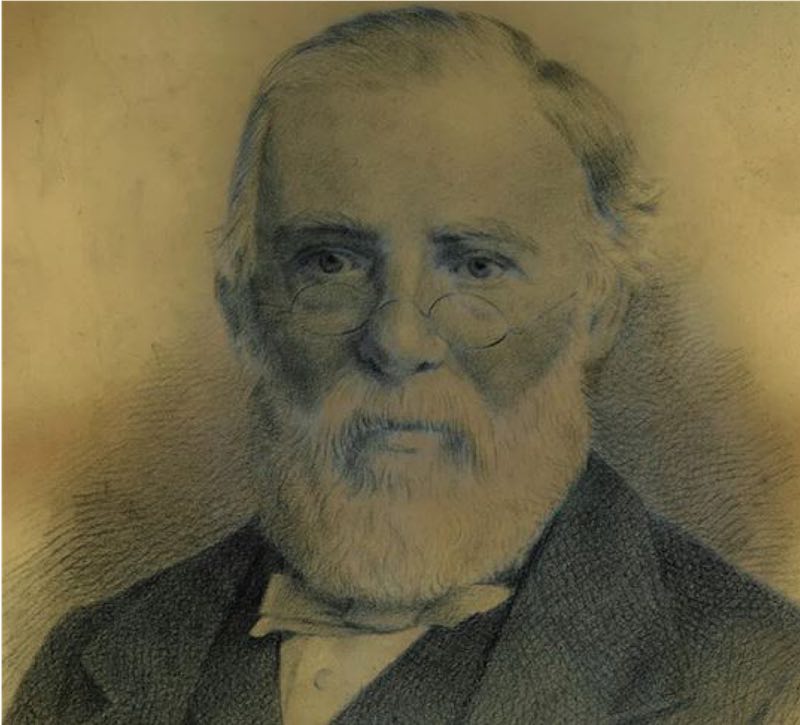
Source: WhiskyStore Presentation
George Duncan founded the company in 1842 and established the firm in Netherkirkgate in Aberdeen. His brother-in-law, William Cadenhead, joined him about ten years later. In 1858, Willam Cadenhead acquired the business and changed the company name. Interestingly, nothing much was known about George Duncan, even though he was the founder. William Cadenhead, on the other hand, was famous not only as a vintner and distillery agent. He was also a renowned local poet in his time.
William Cadenhead passed away on the morning of Sunday, 11 December 1904. His nephew, Robert W. Duthie, succeeded him in the business. Robert grew the business beyond what his uncle could have imagined, creating what the present-day Cadenhead company is famous for – Single Malt Scotch Whisky and Demarara Rum. He actively marketed the company, creating the slogan, “By Test the Best”. Robert also developed Cadenhead’s brands of whiskies, the blends Putachieside and Heilanman.
In the depths of depression in 1931, the financial health of the company deteriorated. Things got worse when Robert was killed in a freak accident while on his way to see his bank manager. He left the company in the hands of his two sisters. Unfortunately, the sisters had no clue about running the business. Determined to keep the Cadenhead family name, the sisters put Miss Ann Oliver, a long-term employee in charge.
Ann Oliver was not the most prudent of business operators. She refused to keep up with times and ran the business in her style. It continued to prosper for a while, but by the early 1960s, William Cadenhead Limited was in trouble. Eventually, the Trustee persuaded Ann to retire and sell the business. At the times of sales, the warehouse and office were full from cellar to ceiling with stocks. The family engaged Christie’s, the famous auction house to help with the sales.
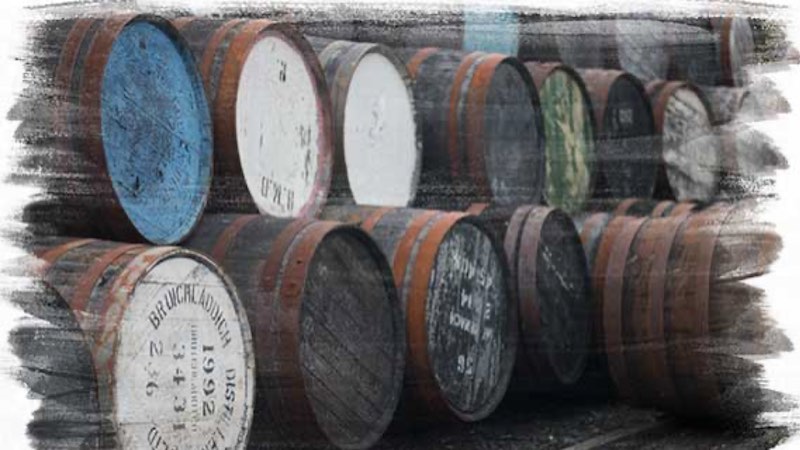
Source: WhiskyStore Presentation
The sale of stocks from William Cadenhead took place on 3rd and 4th of October 1972 and went down in history as the largest sale of wine and spirits in Great Britain to that date. The catalogue ran 167 pages. The result was a six-figure surplus over the liabilities of the company.
After the stocks were liquidated, J&A Mitchell & Co Ltd bought the goodwill, premises, etc. of William Cadenhead Limited. The owners of Springbank Distillery purchased the firm with the expectation of receiving glass bottles, which was in shortage. However, what Mr Hedley Wright, the owner of J&A Mitchell, received was a company with a good reputation and future wealth. Nobody knew what happened to those glass bottles that he was after.
J&A Mitchell moved William Cadenhead Limited from Aberdeen to Campbeltown after the purchase. It marked the start of the modern era for Cadenhead. J&A adapted the business for modern times but kept the traditional way of choosing what whiskies to bottle. Cadenhead gets a new motto: “We bottle when our spirits are remarkable, not marketable.” This is purely the reason why we see such vast differences from Cadenhead bottlings. J&A also bottles all their spirits in Campbeltown.
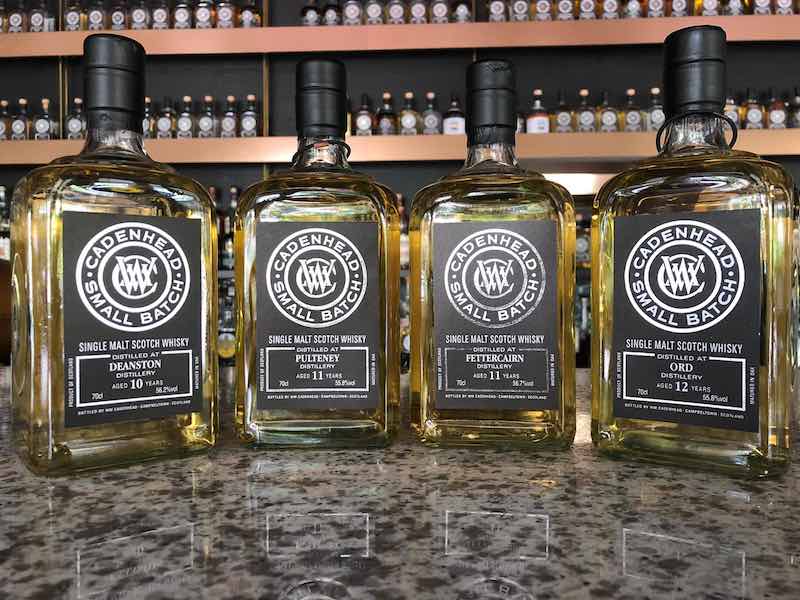
Source: Sarah Thallon
I am getting thirsty from all that history, so let’s dive into the four whiskies that we tasted. Sarah selected four young and frisky whiskies for us to try, and I was pretty excited to try both the Deanston and Fettercairn as I am a fan of those distilleries. All four whiskies have their attractive characteristics, but my personal choice is Fettercairn. I had tried young Fettercairns that were terrible, but I know that Cadenhead is likely not to disappoint. I was right! The Fettercairn 11 Years Old is terrific!
Cadenhead makes distinctive labels that are simple to understand. The square bottles have two types of labels – the black and the gold. Black labels mean that the whisky is small-batch, consisting of two or three casks blended to one. It is cask strength and non-chill-filtered. Gold labels indicate that the whisky comes from a single cask, cask strength and non-chill-filtered.
There are also tall, round bottles that we may find elsewhere that are named “Authentic Collections”. The labels are green with gold stamping. Whiskies in that collection are also from single casks, cask strength and non-chill-filtered.
Everyone’s palate is different, and hence our preferences are also different. What I like may not be what you like, and vice versa. The ranking for the whiskies during the Zoom tasting was pretty varied, with many people voting for the Pulteney and Deanston. I think that the highest vote probably went to the Pulteney, which interestingly, received my lowest vote. Hahaha…
My ranking is Fettercairn –> Deanston –> Ord –> Pulteney. I assumed that there is bias on my part, but the Fettercairn was really on point for me. The balance between spice, floral, fruity, wood and the overall mouthfeel was fantastic. The Deanston was good too, oily texture and fruity all the way. Add in some water and the spice will also tone down!

Source: The Whisky Store
If you are interested to buy some of these awesome whiskies, head over to The Whisky Store to see what they have in store! All Cadenhead bottles are priced at wholesale prices so grab whatever you like and check out!
One more thing. If you are keen to join Sarah and her team for a tasting, check out the newest tasting happening next Tuesday, 14th July at 8 pm! The featured distillery is Glen Scotia from Campbeltown and a very special guest will be speaking from the distillery itself! Find out more here.
11311 Harry Hines Blvd
Dallas, TX, United States
(555) 389 976
dallas@enfold-restaurant.com
